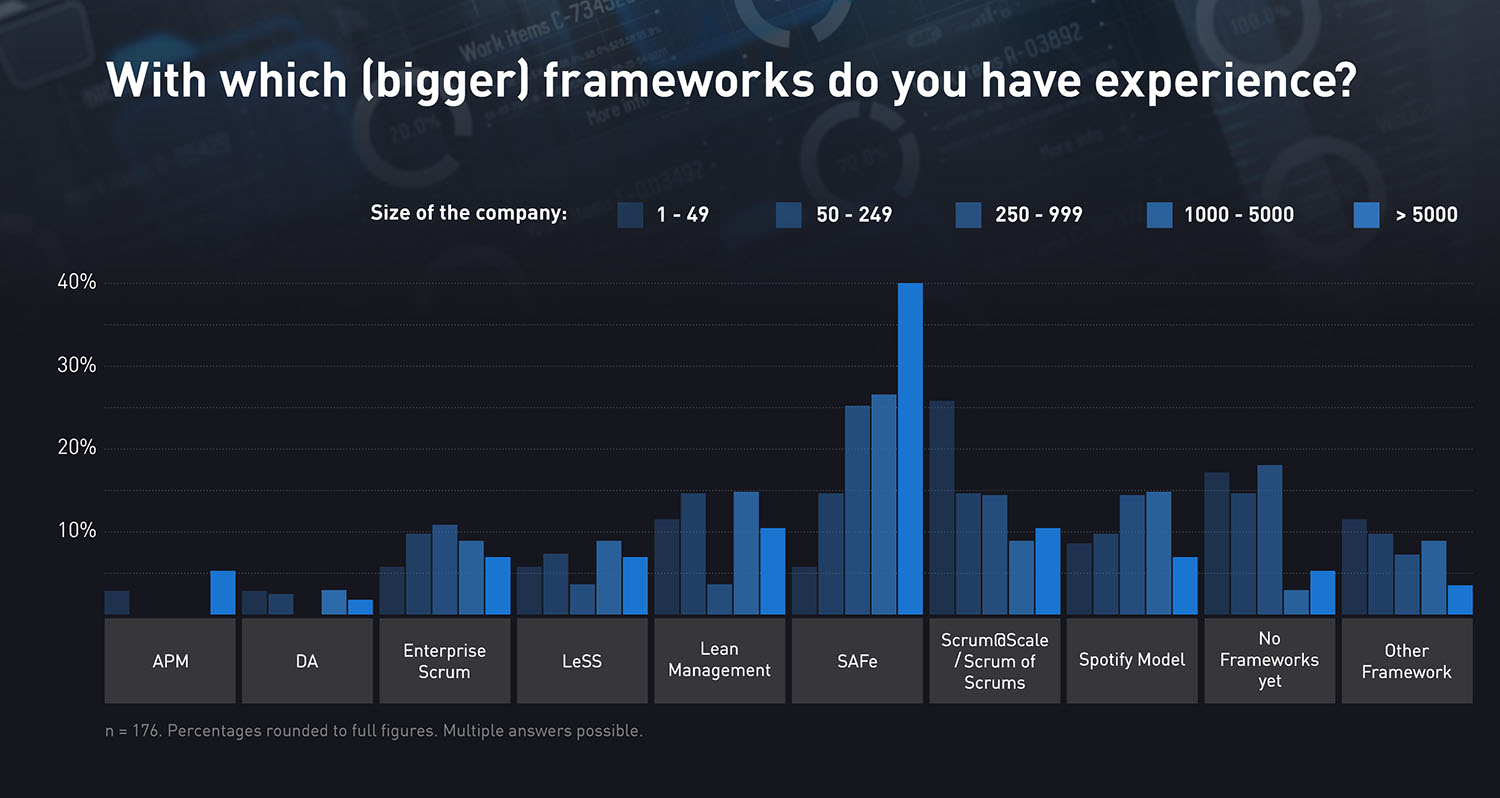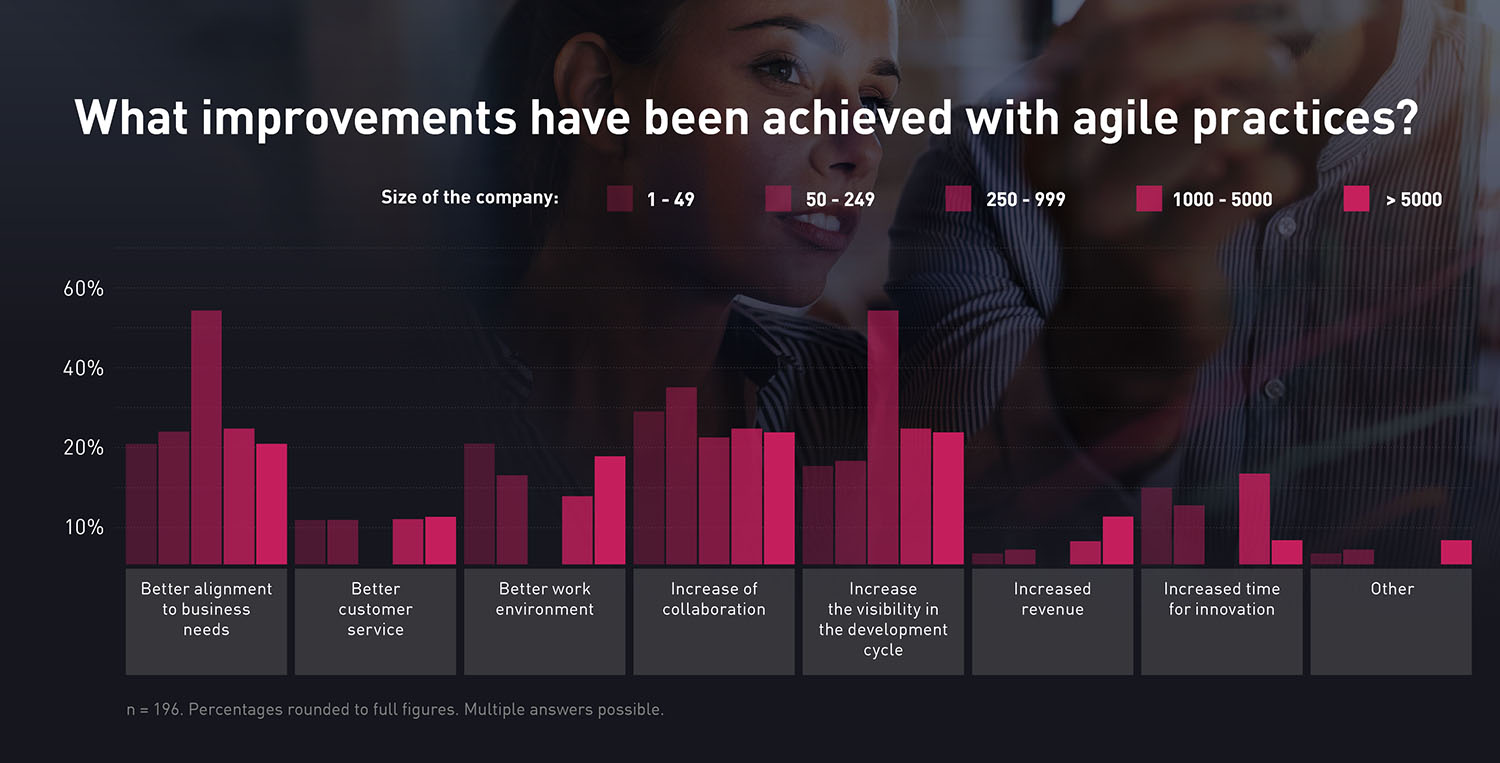
What is the current state of agile software development?
Now that more and more companies are claiming “We are agile”, we asked around in IT departments worldwide to find out how agile software development is progressing.
Nowadays, IT staff are used to working in agile projects. The majority of those who conducted our survey can look back on more than five years of experience, often in different companies. They can tell us which tools, frameworks and methods are particularly popular and what benefits “agile” actually brings to companies.
Agile frameworks
Let’s start with the frameworks. There are a large number of frameworks available for agile projects, but they are not mandatory. Of those surveyed, 22% actually use frameworks only sometimes and 9% do not use any at all.
However, this says nothing about the quality of the project. After all, it would be worse to be “chained” to a framework that offers no added value at the end of the day. Whatever works is right.
It is interesting to note the corresponding preference for frameworks depending on the size of the company.

There are also industry-specific preferences:
- Automotive industry: SAFe (46.15%) – LeSS (15.38%)
- Retail: SAFe (35.29%) – LeSS (11.76%)
- Industry & Technology: SAFe (38.46%)
- Financial sector: SAFe (20%) – Enterprise Scrum (16 %) – Lean Management (16%).
- Insurance: SAFe (33.33%)
- IT sector: Scrum@Scale/Scrum of Scrums (20%) – SAFe (15%) – Spotify model (13.33%)
Surprisingly, as many as 10% in the IT sector do not work with any framework at all. This is also quite common in sectors such as tax and legal (40%), education and science (25%) and marketing, PR and design agencies (22.2%).
In addition to frameworks, there are also agile methods. The most popular ones by far are Scrum and Kanban.
Agile tools and practices
The situation here is somewhat different from that for frameworks. Only 0.3% stated in our study that they do not use any. Atlassian JIRA is by far the most frequently used tool. However, this alone says nothing about satisfaction. Only 50.4 % attest to this. Much more popular are the good traditional Microsoft Excel and Mural/Miro.
As always, we also believe that agile tools and practices must add value. And so we explicitly asked in the study about the improvements that have been achieved with them.
These are the results:

Regardless of size, companies seem to be very satisfied with their agile tools and practices. At least 83.3% of respondents say so.
Measurements
Measuring success in terms of team performance is shamefully neglected in many areas. This is also the case with agile software projects. 26% only partially measure the work of their developers and 33% do not measure it at all.
This inevitably leads to the question of how companies want to evaluate projects. Will they stick to this way of working in the future? Is the cost-benefit factor right? Is there potential for improvement? These are all important questions that could be answered with the right performance measurement.
However, these measurements are only really useful if they are determined by experienced employees, communicated transparently and based on objective criteria. Goals determined by the team itself have proven to be less beneficial. Just like tools, practices, frameworks, etc., success measurements should also be regularly put to the test.
Meetings
No company can do without meetings. This is no different in agile software development. There are a whole series of so-called scrum meetings:
- Sprint Planning
- Daily Standups
- Sprint Reviews
- Sprint Retrospective
These are evaluated differently by employees, which is perfectly fine. They have various benefits and are conducted differently.
What you should pay attention to with meetings is how much time they take and when they are held. Ideally, the work of creative developers should be interrupted as little as possible. It is important to create spaces in which developers are not disturbed.

Some points of criticism
Despite all the love for the idea of agile software development, companies should bear a few things in mind. In many places, “agile” seems to have become an end in itself – as if it were a label. However, this makes no sense at all. Agile practices need to be weighed up for each individual company and should be continuously adapted in order to achieve the desired increase in efficiency.
Dogmatic adherence to rules contradicts the basic agile idea. The results of the study also show very clearly that a different framework, a different method or other meetings are suitable for every company.
Our advice is always to take a flexible approach and check which one brings the greatest benefit. We support our customers in this. If you want to introduce or optimize agile software development in your company, just let us know at experts@striped-giraffe.com or +49-089-416 126-660.
You can find detailed information and other interesting insights into agile software development in our study “THE AGILE REPORT”.
And how about a detour into the development of “agile”? Take a look at our entertaining video “THE AGILE PARADOXON”!
This might also be of interest to you:
VIDEO
The Agile Paradoxon
It started as a revolution… But it became a religion. Watch this snarky video featuring the story of AGILE.
COLLABORATION
Agile big promises
It is important to be clear about how to use “Agile” properly to get the promised enhancements. Learn about our approach.
BLOG
Who pays the bill?
The answer to the question of who actually pays the bill should also clarify who calls the shots in software development.
SPECIAL OFFER
Optimizing your software delivery
In today’s fast-paced digital world, the efficient delivery of software products is crucial. Check out how we can support you in this area.


